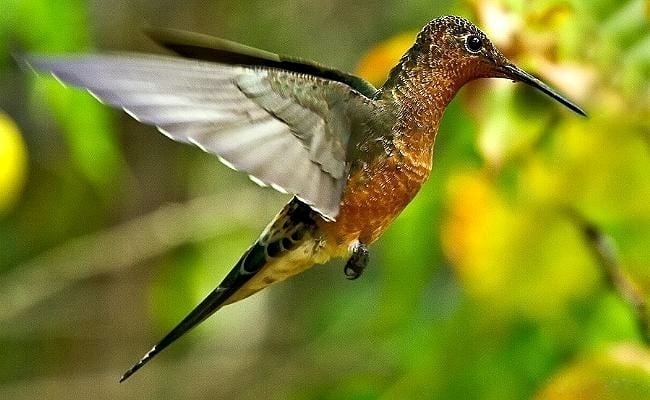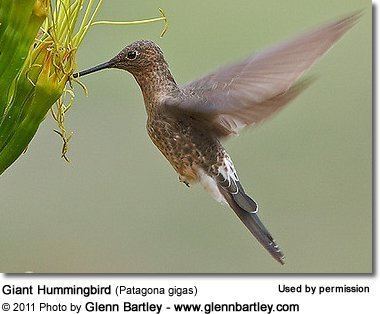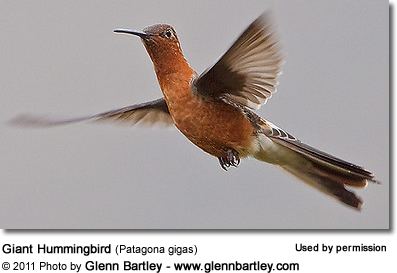Kingdom Animalia Scientific name Patagona gigas Higher classification Patagona Order Hummingbird | Family Trochilidae Phylum Chordata Rank Species | |
 | ||
Genus Patagona
G.R. Gray, 1840 Similar Hummingbird, Mellisuga, Hillstar, Bee hummingbird, Sword‑billed hummingbird | ||
Giant hummingbird
The giant hummingbird (Patagona gigas) is the largest member of the hummingbird family, weighing 18–24 g (0.63–0.85 oz) with a wingspan measuring approximately 21.5 cm (8.5 in) in length, and length of 23 cm (9.1 in). This is approximately the same length as a European starling or a northern cardinal, though the giant hummingbird is considerably lighter due to its more slender build and fairly long bill. It is the only member of the genus Patagona. This weight is almost twice that of the next heaviest recorded species, and ten times that of the smallest humming bird, the bee hummingbird.
Contents
- Giant hummingbird
- Description
- Taxonomy
- Distribution and habitat
- Global range and population
- Behaviour
- FlightAnatomyPhysiology
- Diet
- Reproduction
- Migration
- Cultural significance
- References

Giant hummingbird
Description
In Bolivia, the giant hummingbird is known in Quechua as burro q'enti. The Spanish word burro refers to its dull, relatively unattractive plumage compared to other locally occurring hummingbirds (e.g., red-tailed comet). Typically members of P. gigas can be identified using their comparative size and characteristics such as the presence of an eye-ring, straight bill (longer than the head), dull colouration, very long wings (approaching tail tip when stowed), long and moderately forked tail, feathered tarsi to the toes and comparatively large sturdy feet. There is no difference between the sexes. Juvenile specimens can be determined by observing small corrugations on the lateral areas of the beak culmen.

The sub-species are visually distinguishable. P. g. peruviana has an overall yellowish brown appearance as well as the presence of a white on the chin and throat, where P. g. gigas has more of an olive green/brown colouration and absence of white on the chin and throat.

The giant hummingbird is distinct from other hummingbirds in flight with occasional gliding flight observed, very rare in Trochilids. Literature leads to the belief this flight is strongly correlated to the elongated wings of the giant hummingbird, allowing more efficient glides than other Trochilids. The giant hummingbird’s voice is a singular loud, sharp and whistling “chip”.
Taxonomy
Belonging to the family Trochilidae (hummingbirds), Patagona gigas is one of approximately 331 described species in this family, making it the second largest group of new world birds, trochilids are further divided into ≈104 genera. It is thought that the species is comparatively old and, for the most part, a failed evolutionary experiment in enlarging hummingbird size given it has not diverged and proliferated.
Traditional morphologic taxonomic inquiries show that P. gigas is substantially different from the other taxa of hummingbirds. In 2008 a phylogenetic review established that there is a 97.5% likelihood that P. gigas has diverged substantially enough from the proposed 3 closest phylogenetic clades to be considered belonging to a single specie clade named Patagonini. This lines up with International Ornithological Congress’s (IOC) taxonomic classification that Patagona is a genus containing only P. gigas.
However two subspecies P. gigas gigas and P. gigas peruviana are recognised. These subspecies are thought to have emerged due to partial geographical separation of populations by volcanic activities in the Andes predating the Miocene period, however there remain areas of contact between the species hence the lack of true speciation. The proposed contemporary phylogenetic clade system for hummingbirds suggested by McGuire et al. (2009) accommodates for future study finding a possible separate species of Patagona.
Distribution and habitat
The giant hummingbird is widely distributed throughout the length of the Andes on both the east and west sides. P. gigas typically inhabit the higher altitude scrubland and forests that line the slopes of the Andes during the summer and then retreat to similar, lower altitude habitats in winter months. The species persists through a large altitude range also with specimens retrieved from sea level up to 4600m. They have shown to be fairly resilient to urbanisation and agricultural activities, however the removal of vegetation limits their distribution in dense city areas and industrial zones.
P. g. peruviana has been found from Equador to the South-Eastern mountains of Peru and P. g. gigas from Northern Bolivia and Chile to Argentina. Contact between subspecies is thought to most likely occur around the eastern slopes of the north Peruvian Andes.
P. gigas inhabit the mountainous scrubland and forests that line the slopes of the Andes. The species lives in this habitat over a majority of the mountain range.
Global range and population
The range of Patagona gigas is rather large, and its global extent of occurrence is estimated at 1,200,000 km2. Its global population is believed to be not less than 10,000 adults.
Behaviour
Hummingbirds are extremely agile and acrobatic flyers, regularly partaking in sustained hovering flight, often used not only to feed on the wing but to protect their territory and perform courting rituals. P. gigas is typical in that it will brazenly defend its precious energy-rich flower territory from other species and other giant hummingbirds. These birds are typically seen alone, in pairs or small family groups.
Flight/Anatomy/Physiology
For a hummingbird P. gigas averages a slow hovering state of 15 wing beats per second. Resting heart rate for P. gigas is 300/min and peaks at 1020/min. Energy requirements for hummingbirds do not scale evenly with size increases, meaning a larger bird such as P. gigas requires comparatively more energy per gram to hover than a smaller bird. This demanding homeostatic state means that consuming a huge 4300 calories/hr is the estimated requirement to sustain this. This along with the oxygen availability/hypobaric limitations for hovering at altitudes that the giant hummingbird lives in appears to suggest that P. gigas is likely to be very close to the viable maximum size for a hummingbird.
Hummingbird skeletal anatomy is vastly different to that of a traditional forward flying bird, with elongated hand bones, shortened humerus and forearm bones, thickened wing bones to support straight wing beating and re-designing of the shoulder joint to accommodate the rotation of the humerus allowing production of thrust on back strokes.
The cellular anatomy of hummingbird's flight musculature is very similar to other small bird species, all their flight muscles are composed of only fast oxidative glycolytic muscle fibres which allow the sustained high frequency wing beats typically seen in these birds. These muscle fibres are filled with mitochondria (around 50% of volume) enabling high frequency wing beats to be sustained over extended periods using oxidative energy. A very well developed pathway that transports sugars to the muscles for use very efficiently supports these mitochondria: hummingbirds are also thought to be able to oxidise dietary fructose directly without the additional step of converting it to glucose. These factors combine to allow hummingbirds to consume oxygen at the highest known rate (over 5x the rate of dogs). Hummingbirds also have a higher amount of this energy thirsty muscle type elsewhere in their skeletal musculature, this is thought to help them combat loss of heat to the environment due to large surface area/volume ratio.
Additionally, Trochilids have developed two useful physiological responses that allow them to survive in harsher temperatures and environments that are lacking or devoid of food for extended periods. They can enter a resting hypothermic state to conserve energy but be able to respond to external stimuli(McKechnie & Lovegrove, 2002). Or are even able to reduce their body temperature and enter torpor for hours on end - this reduces their metabolic rate and allows great energy conservation in extreme circumstances. Hovering flight metabolic demand has sculpted even the genome of Trochilids with them maintaining the smallest genomes in the avian sphere.
Diet
P. gigas is obligate nectarvorious and feeds from a range of flowers. The female giant hummingbird has been observed ingesting sources of high amounts of calcium (sand, soil, slaked lime and wood ash) post reproductive season to replenish the calcium used in egg production, nectar has a very low calcium content necessitating this. Similarly a nectar based diet is low in proteins and various minerals, this is countered by consuming insects on occasion. Though there is a report of a nesting Broad-tailed hummingbird that sustained itself for several days only upon arthropods, this suggests that insects may have a larger part in hummingbird diet in some instances than previously thought. Supporting this is the fact that hummingbirds have evolved the ability to bend their mandibular bone midway down, manipulate their bottom jaw laterally and snap their jaw shut faster to accommodate better capture of flying insects.
P. gigas regularly visits and feeds from the flowers of Puya genus in Chile with which it enjoys a symbiotic relationship with trading pollination for food. Due to the extremely high metabolic requirements of such a large hovering bird at high altitudes, Patagona is aided by its wide range of flowers it will feed from, allowing for more efficient energy collection. It is known to feed from multiple columnar cacti species including Oreocereus celsianus, Echinopsis Atacamensis Subsp. Pasacana and Salvia haenkei. There is limited primary literature for exactly how wide the scope of P. gigas diet is, due probably to the challenge of its vast distribution. But drawing inference from the large amount of nectar required to be routinely ingested by such a large hummingbird it is safe to say it is quite the generalist out of necessity.
Interestingly, the majority of flowers visited by hummingbirds are reported as being red in colour. This has traditionally been thought to be due to hummingbird preferencing red that dictated the evolution of the flowers it visits and pollinates, however this view has not been well backed in experimental findings, instead it is hypothesised that hummingbird flowers are red as a form of communication that allows easy identification of the best flowers for a bird to visit when it is travelling through new areas, a symbiotic advantage.
Considering the energy rich nature of nectar as a food source it attracts a large range of visitors apart from the desired hummingbird, which will often be the flower’s most efficient pollinator due to evolutionary pressures. These other visitors, because they are not designed to access the well hidden bounty of nectar often inflict damage to the flowers and prevent further nectar production. P. gigas, because of its high energy requirements, is known to alter its foraging behaviour as a direct response to nectar robbing from other birds and animals, this impacts the viability of the hummingbird in an area with significant numbers of nectar robbers as well as indirectly effecting the plants with reduced pollination occurring. If these nectar thieves are ever introduced species it is reasonable to predict that their activities will significantly impact the local ecosystem through the previously mentioned mechanisms over a moderate period of time. This could prove to be a future risk for P. gigas populations due to their close to physical limit metabolic demands.
Reproduction
There is little specific primary literature that has investigated P. gigas’s reproductive practices and therefore educated generalisations from literature on other hummingbird species can be drawn on. Hummingbird males tend to have polygynous, occasionally promiscuous, behaviours and no involvement post copulation. A P. gigas nest is small considering the size of the bird, typically made near water sources and perched upon a branch parallel to the ground of a tree or shrub. Females build the nest and lay a clutch of two eggs in the Summer period.
Incubation is a particularly tricky stage for hummingbirds, with their small body mass and high energy requirements they need to leave the nest more regularly than most land birds. However, their eggs have adapted to be resilient to temporary significant fluctuations in temperature (one record shows an egg dropping to 14.5 degrees Celsius) so long as the average temperature stays at an acceptable range. They can even maintain a hypothermic or torpid state at night to save their own energy reserves but keep the egg somewhat stable. Hummingbirds have the highest amount of feathers per surface area which allows them exceptional insulation that is no doubt useful during this taxing incubation that tends to last 15–22 days depending on species. Nestling period is shown to last between 18–26 days for hummingbirds.
Relevant research in general bird reproductive trends has shown that Southern Hemisphere birds on average show smaller clutches when compared to Northern situated Avian populations, there is much speculation behind why this is the case but there is no agreed upon current theory as of yet.
Migration
P. gigas migrates in summer to the temperate areas of South America reaching as low as 44 degrees South. Correspondingly they migrate North to more tropical climates in winter (March–August), though not usually venturing higher than 28 degrees South.
Cultural significance
P. gigas holds significant value for some of the aboriginal inhabitants of the Andes. The people of Chiloé Island believe that if a woman captures a hummingbird then they will gain great fertility from it. This is also the species that the people of Mapuche territory of Chile were inspired by to create the Nazca hummingbird geoglyph.
